The Best Snowboard Gear of 2023
This article originally appeared on Outside
Piecing together the right snowboard gear is like forming a rock band. Snowboards are the obvious frontmen: flashy, attention-grabbing, soaking up more limelight than they're due. But even the best boards are nothing without boots and bindings, the underappreciated drummers and bassists that keep the jams cohesive and the crowd dancing. Below, you'll find the makings of a killer rhythm section, no matter if you're headlining the resort or touring the backcountry.
Read more: The Best Snowboards of 2023
How We Test
Number of testers: 30+
Number of products tested: 35+
States: California, Nevada, Utah, Alaska, Washington, Wyoming
Longest in-bounds days: bell-to-bell at Sugar Bowl, four days in a row
Longest backcountry day: A 13-hour, 9K+ mission in the Eastern Sierras
Broken Boots: Three
Dislocated Shoulders: One
Torn Meniscus: One
Heli Days: One
Cases of Fat Tire: 18
This year, Outside's Snowboard Test was a five-day affair at Sugar Bowl, an unpretentious mom-and-pop Tahoe resort with some of the best freeride terrain in the Lower 48. Mother Nature cooperated, and our spring test window was blessed with every type of conditions imaginable: we started with spring slush and manicured groomers, then transitioned to frozen crud and storm shredding, before capping off the week with a couple of days of deep, delectable powder. Factor in Sugar Bowl's non-existent lift lines, and we couldn't have asked for a better test window.
We couldn't have asked for better testers, either. A crew of 30-plus riders joined the fray, ranging in age from early 20s to early 50s, and skill levels from solid intermediate to local legend. Testers included a splitboard guide from the Eastern Sierra, an avalanche safety course instructor from Crested Butte, Colorado, several members of the Sugar Bowl park crew, a snowboard buyer for a local shop, banked slalom podium regulars, and a handful of snowboard coaches. While a ton of new blood kept the test fresh, the core of the crew consisted of test veterans, several of whom have been reviewing snowboard gear for Outside for nearly a decade.
In addition to boards, we also called in submissions for snowboard gear--boots, bindings, accessories--in early March. This gave veteran testers a chance to break in certain gear and gather feedback leading up to the test. This is especially helpful for backcountry gear, as it's key to put in long days on the skintrack in order to accurately assess durability and utility. As such, we put this category of gear to the test in Alaska, Utah, Washington, Wyoming, and the Eastern Sierra before we even arrived at Sugar Bowl.
Of the 35-plus total snowboard gear submissions, we brought the top 80 percent to our test week. There, we had testers fill out boot and binding forms that break down everything from comfort and longevity to ideal applications and target audience. Then, we sent contending gear home with select testers to continue analyzing it until the snow melted. Finally, we checked in once more before we began to compile our final list.
Learn more about our our snowboard tests with this behind-the-scenes look at last year's event
Meet Our Lead Tester
Drew Zieff is a Tahoe-based freelance writer and a lifelong snowboarder. In addition to directing Outside Magazine's snowboard test, a role he's handled since 2016, he directs Backcountry Magazine's splitboard test, waxes on the Natural Selection and snowboard culture for Whitelines Snowboarding, and nerds out on snowboard gear and travel for REI, Gear Junkie, Gear Patrol, and Popular Mechanics, among others. He spends his winters testing snowboard gear in his backyard backcountry zones or up at Palisades, as well as chasing stories and storms to snowboard meccas like Alaska and Wyoming, British Columbia and Japan. His summers? They're mainly spent at his desk, sifting through review forms and spec sheets, compiling our snowboard reviews--although he occasionally disappears in his custom-built 2006 Chevy Express for a few days when there's swell on the coast.
The Reviews: The Best Snowboard Bindings of 2023
Union Atlas Pro ($450)
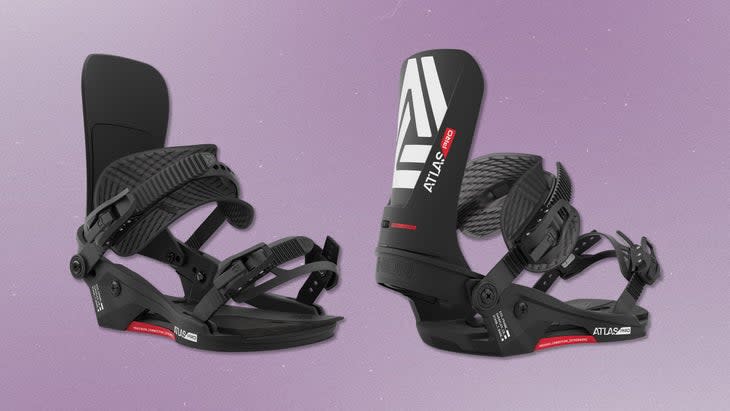
Weight: 2 lbs. per binding (M)
Size range: S-L
The versatile, bombproof, all-mountain Union Atlas is one of our all-time favorite bindings, so when Union debuted the Atlas Pro for 2023, our testers were damn near salivating. This drool-worthy build sports the same responsive highback (but stiffened for 2023) and Duraflex baseplate as the Atlas. However, the Atlas Pro is 15 grams lighter per binding and more responsive thanks to an ultra-reactive carbon footbed, streamlined toe cap, and more rigid, hypersensitive ankle straps. "The Atlas Pro is a notch stiffer, lighter, and more responsive than the Atlas. Pair it with a big mountain board or beefy all-mountain shape and the carbon gas pedals let you approach light speed," said a tester who spent the majority of last season on the Atlas and this season on the Pro. His recommendation: "Intermediate and up all-mountain riders who appreciate a balance of comfort and response will prefer the cushiness and canting of the Atlas, while aggressive freeriders and slow-sign-ignoring resort rippers will fall in love with the streamlined, elite build of the Atlas Pro."
Bottom line: A top-of-the-line binding for advanced riders who crave quality and won't compromise on response.
Jones Orion ($370)
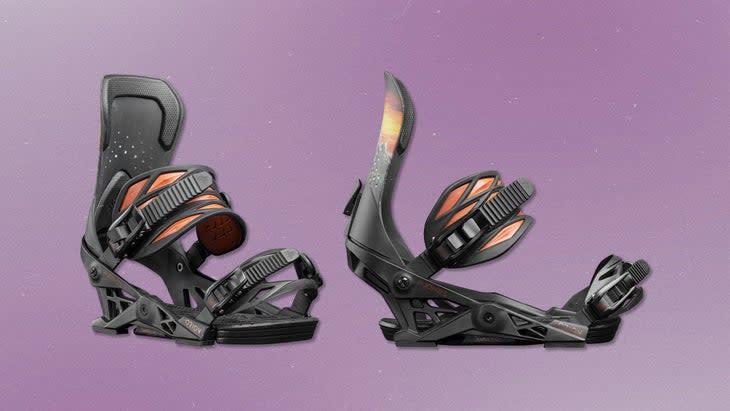
Weight: 1.9 lbs. per binding (M)
Size range: M, L
New for 2023, Jones' Orion binding caters to all-mountain cruisers and creative freeriders who crave a responsive, reliable ride with tweakable, mid-soft flex. The Orion's highback is stiffer at the heel cup and softer towards the calf, and a surfy rider reported, "When transitioning from edge to edge, the highback gives you all the support you need. When you start playing with other directions--off-axis tweaks, contorted carves, nose or tail presses, et cetera--the softness toward the top of the highback lets you twist like a yogi."
Edge-to-edge prowess also comes courtesy of Now Snowboarding's revolutionary SkateTech, introduced by the British Columbia binding builder in 2012, which is at the core of all of Jones' bindings. Essentially, SkateTech refers to a baseplate that pivots around the disc housing like a fulcrum, efficiently leveraging rider weight and transferring energy to four bushings at the corners of each binding. Not only does this system yield what our tester called "instantaneous response," but the rubbery, dampening bushings also "absorb more chatter than the NSA." Between the bushings and a thick EVA foam footbed, he reported the Orion was comfortable enough for "first-to-last-chair riding called for by late season powder days and closing weekend festivities." And if you like to customize your setup, the bushings can swap out for a stiffer or softer ride feel. What's more, the flexy-yet-supportive ankle straps are customizable, too: swap the left and right ankle straps to bounce between freeride and surf modes. Freeride mode locks in the ankle for straight lining steeps and tackling technical faces, while surf mode frees up range of motion for slaying side hits and flowy pow days. Pro tip: If you're looking for a slightly stiffer all-mountain binding that utilizes the same NOW Snowboarding SkateTech, check out NOW's Drive.
Bottom line: A customizable, comfortable, and approachable binding that can cruise one day and charge the next.
Bent Metal Binding Works Stylist ($280)
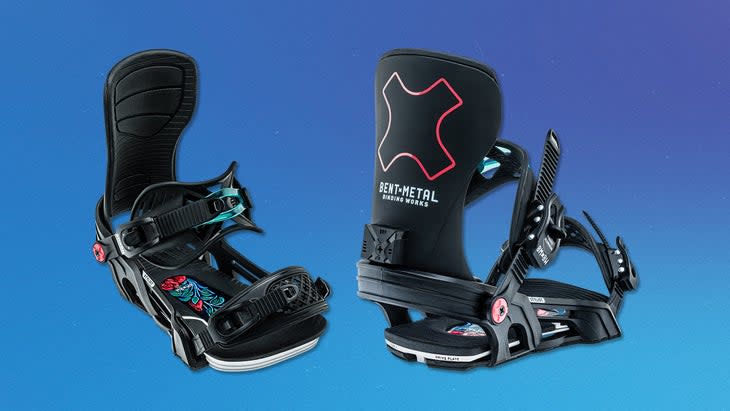
Size range: M, L
Shred the mountain, not your budget with the women's Stylist, an all-mountain binding that's as capable as it is affordable. Performance stems from a boot-hugging, asymmetric highback; soft-flexing, compressible ankle straps; and a medium-stiff magnesium and EVA foam Drive Plate. Bent Metal's technical riff on a traditionally simple binding tech, Drive Plates are swappable, padded, energy-transferring footbeds crafted using the same layering and lamination techniques as modern snowboards. "The Stylist Drive Plate is responsive yet cushy. They have enough padding underfoot for comfort on hard landings, but enough structure for high-level performance and quick response," testified a snowboard coach who felt the design could take on anything from "street-style rails to bumped-out chutes." While she lamented the lack of an adjustable heel cup, overall impressions were through the roof from the jump, and that surprised her. "I am picky about bindings, and even when I get a new pair of the bindings I've had for years, they take a few days to break into where I am happy with them. So I was stoked to like these by my second run," she said. She recommended the Stylist for women who demand "high performance as well as high comfort levels" from their kit.
Bottom line: Bent Metal's affordable, all-mountain Stylist suits riders who want to rip the entire mountain without breaking the bank.
The Reviews: TheBest Snowboard Boots of 2023
Thirtytwo TM-2 Jones ($425)
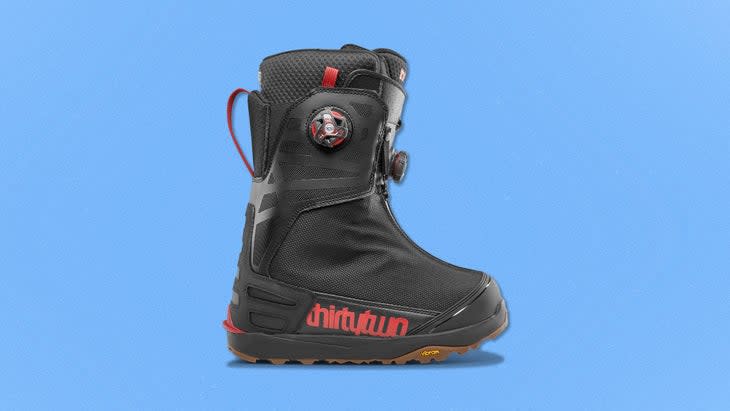
Size range: 6-13
If you don't have space in your board bag--or budget--and need a single pair of boots that can handle touring and resort riding alike, check out the TM-2 Jones. This boot is capable of pinning it down Palisades' fabled fingers one day and skinning deep into Desolation Wilderness the next, thanks to an articulated calf and rugged outsole that allows the otherwise downhill-oriented boot to tour and scramble comfortably. The TM-2 is a softer, more versatile, and more approachable option than the beefier, ultra-stiff, mountaineering-ready Jones MTB. Still, a Sierra-scaling splitboard guide rated them high on traction and backcountry utility. He dug the "Vibram sole and crampon-compatible heel, combined with a reinforced toe for kicking steps." A lack of breakable lacing parts was also appreciated. "I love laces and found the tension strap to be super utilitarian as a splitboarder," he said, although he did wish the laces went higher on the tongue. All told, he called the TM-2 Jones his "favorite backcountry boots," and noted that snowboarders who can justify multiple pairs of boots may reserve the TM-2 exclusively for touring applications. While he appreciated the ride feel in-bounds, he admitted to preferring more streamlined but still responsive boots like the Vans Verse or Ride Insano in pure resort scenarios. However, on shred trips that involve both the front and backcountry, the decision is clear.
Bottom line: A versatile, stiff boot for riders who alternate between touring and tearing the resort to shreds. It has mountaineering chops, but it's still a snowboard boot at heart.
Burton SLX ($670)
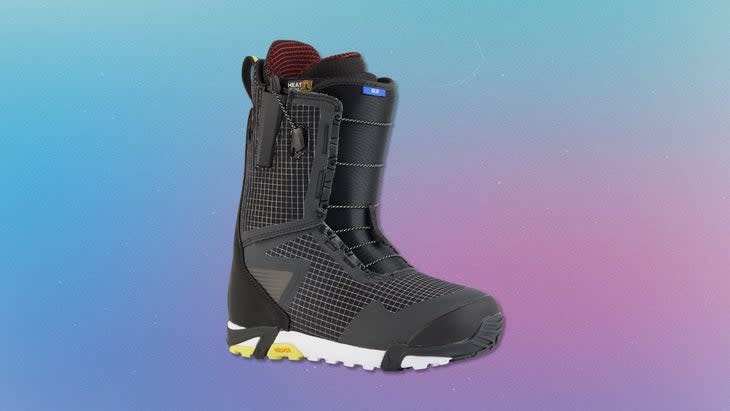
Size range: 7-13
Burton's SLX is more overflowing with tech than Christmas stockings in Silicon Valley: a welded backstay, a Dyneema-wrapped shell, and a Carbitex-buttressed ankle zone give the boots their backbone. Usually, boot builders reserve such bells and whistles for ultra-stiff, freeride-focused boots, but the SLX plays the middle ground with grace, and the resulting flex is responsive enough for technical charging and still tweakable when airborne. "I tested these boots on sled laps and a steep heli day in Alaska, spring storm and corn cycles in Tahoe, and resort days in Utah, riding everything from pow to ice to side hits," relayed an all-mountain tester. He appreciated the workable yet reliable flex, found Burton's proven yank-to-tighten Speed Zone lacing simple, secure, and easy to adjust on the fly, and reported: "the nominal outsole footprint makes toe and heel drag a thing of the past."
One point of concern: after 20-plus days of testing this spring, we did notice a slight crease forming where the upper meets the lower, and we've read a few customer reviews citing newer construction doesn't last quite as long as older SLX iterations. Also, Burton has plenty of cheaper boots in a similar medium stiffness profile--we're big fans of the Photon if you want to save some dough. That said, if you're an advanced all-mountain rider who spends more than 30 days annually on snow, the high-performance SLX is well worth the high price tag.
Bottom line: A premium all-mountain boot that's maxxed out with tech and boasts a minimal footprint.
How To Buy Snowboard Gear
Shopping for snowboard boots, bindings, and accessories can be overwhelming. Here are a few tried-and-true tips to make the process as smooth as possible.
If possible, shop for boots before you shop for boards and bindings. Some boots, like the Burton SLX, have compact footprints, which means you're less likely to have toe or heel drag on a narrower board. If you end up buying a boot with a bigger footprint, or you have a size 10.5 boot or higher, you may want to consider a mid-wide, wide, or volume-shifted board.
Invest in insoles. Even high-end snowboard boots often sport garbage insoles (as reported by a tester who fits boots for a local shop), and one of the best ways to improve fit, comfort, and performance is with an aftermarket insole. We're partial to Green Superfeet. Oh-and don't forget to heat mold those new boots, too!
If you can, support your local snowboard shop. If you prefer to shop online, buy from a reputable online retailer like REI or Backcountry, that has a decent return policy.
More 2023 Gear Guide Reviews
For exclusive access to all of our fitness, gear, adventure, and travel stories, plus discounts on trips, events, and gear, sign up for Outside+ today.

